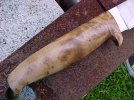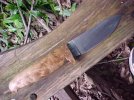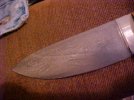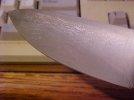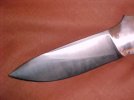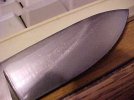- Joined
- Jul 9, 1999
- Messages
- 3,316
Here's a forged to shape drop point in 1084. It's 5/32" thick and 4 5/8" long in the blade and is full height flat ground. Overall length is 10" and it is of blind tang construction. The handle is a piece of interesting maple that's been sitting around since 1995. I was waiting for the right knife to put it on and figured this one would be the one.
When I etched it for 60 seconds in a 4:1 ferric chloride/water mix, I got this random damascus looking pattern on both sides of the blade. Can anyone shed some light on what it might be?

All the best,
Mike U.
Edited to add info.
When I etched it for 60 seconds in a 4:1 ferric chloride/water mix, I got this random damascus looking pattern on both sides of the blade. Can anyone shed some light on what it might be?
All the best,
Mike U.
Edited to add info.


